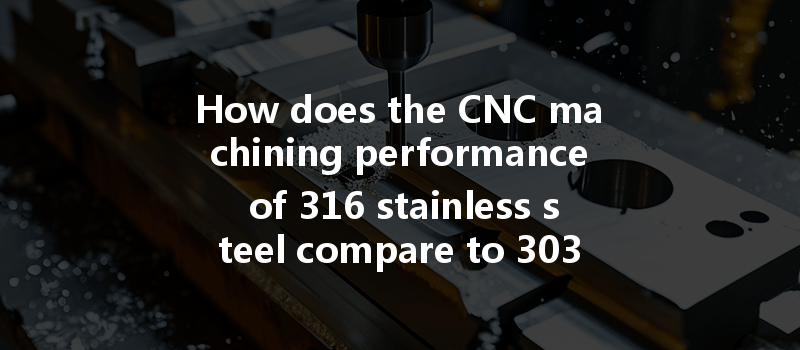: The Impact of Material Choice in CNC Machining
Did you know that stainless steel is among the top three most commonly used materials in CNC machining? Its diverse range of mechanical properties makes it suitable for various applications, from manufacturing consumer goods to creating complex aerospace components. When it comes to stainless steel, two grades often come into the spotlight: 316 and 303 stainless steel. The question arises: how do their machining performances stack up against each other?
In this comprehensive blog post, we will explore the CNC machining performance of 316 and 303 stainless steel, examining the key characteristics, advantages, challenges, and applications of each grade. We’ll delve into various aspects, including machinability, surface finish, tool wear, and overall productivity. Whether you’re a CNC machining professional, a material scientist, or simply interested in manufacturing processes, this blog aims to provide valuable insights that will enhance your understanding of stainless steel machining.
Understanding Stainless Steel Grades
Before we dive into the specifics of CNC machining performance, let’s first clarify what 316 and 303 stainless steel alloys are and the fundamental properties that define them.
What is 316 Stainless Steel?
316 stainless steel is a type of austenitic stainless steel known for its excellent corrosion resistance, especially against chlorides and marine environments. This alloy typically contains:
The addition of molybdenum enhances its resistance to pitting and crevice corrosion compared to other stainless steel grades. Due to these properties, 316 stainless steel is commonly utilized in pharmaceutical, food processing, chemical, and marine industries.
What is 303 Stainless Steel?
303 stainless steel is another type of austenitic stainless steel known for its ease of machining. It contains a higher sulfur content, which enhances its machinability without compromising too much on other properties. Typical composition includes:
303 stainless steel is often used for components that require extensive machining, such as shafts, fittings, and fasteners.
Comparing Machinability between 316 and 303 Stainless Steel
Machinability is a crucial factor in selecting materials for CNC machining. It refers to how easily the metal can be cut and shaped by a machining process. Let’s delve into the key parameters that affect machinability.
Machining stainless steel can be challenging because of its tendency to work harden. When comparing the cutting speed and feed rate, 303 stainless steel has an advantage due to its inherently better machinability.
Choosing the right tools for CNC machining is essential for achieving optimal performance. The choice of material, coating, and geometry of the cutting tool plays a vital role.
The desired surface finish plays a significant role in CNC machining. It affects the performance and aesthetic appeal of the final product.
Performance Metrics in CNC Machining
To truly compare the machining performance of 316 and 303 stainless steel, it’s essential to evaluate the following performance metrics:
One of the major considerations in CNC machining is the wear rate of the cutting tools. Tool wear affects productivity and overall machining costs.
The type of chips produced during machining can indicate the efficiency of the process.
Specific Applications for Each Stainless Steel Grade
Next, let’s look at where each stainless steel grade shines the brightest in real-world applications.

Applications for 316 Stainless Steel
Given its corrosion resistance, 316 stainless steel is highly utilized in:
Applications for 303 Stainless Steel
303 stainless steel excels in applications that require high volumes of precision machining, such as:
Challenges in CNC Machining Both Alloys
While 316 and 303 stainless steel may have distinct advantages, each also presents unique challenges for CNC machining.
Both materials can undergo work hardening, but 316 stainless steel is more susceptible. CNC operators need to implement strategies such as:
Managing heat during machining is vital, especially for 316 stainless steel, where excessive heat can lead to tool failure. Options include:
Cost Comparison and Economic Implications
When choosing between 316 and 303 stainless steel for CNC machining, the initial cost may not tell the whole story. Consider the following economic implications:
Tooling Costs
Labor Costs
Material Cost
Best Practices for Machining Stainless Steel
To optimize the CNC machining performance of both 316 and 303 stainless steel, consider the following best practices:
: Choosing the Right Stainless Steel for CNC Machining
In summary, the comparison between 316 and 303 stainless steel in CNC machining showcases the importance of material selection in manufacturing processes. Each grade has its own set of advantages and challenges; 303 stainless steel excels in machinability and speed, while 316 stainless steel brings exceptional corrosion resistance.
As a reader, understanding these differences is crucial for making informed decisions in CNC machining projects. Consider the specific requirements of your application, including environmental factors, the need for precision, and overall costs, to achieve optimal results.
Ultimately, whether you lean towards 316 or 303, being well-informed will lead to improved machinability, reduced costs, and higher-quality finished products. Being mindful of material selection is not just a technical consideration but a strategic advantage in today’s competitive manufacturing landscape.






